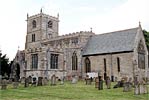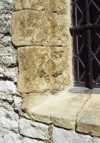 Norwell Norwell
St Laurence
Stonework
Exterior
The exterior stonwork of the church is chiefly blocks of ‘skerry’
sandstone, Magnesian limestone and Lincolnshire limestone, but there are other
stones present in small quantities. The majority of stones come from quarries
in Nottinghamshire and Lincolnshire.
The main church building, including the tower and footings, is made of large
pale grey blocks of Dolomitic ‘skerry’ sandstone. This stone is
hard and difficult to work and is resistant to weathering. The stone may have
come from local quarries such as Tuxford, Maplebeck, Laxton or Kneesall. It
has not been available for the last 100 years.
The following stones are also found:
 Magnesian limestone
(Dolomitic). It is hard and difficult to work and would have come from a Mansfield
quarry. It is found in quoins, window surrounds, buttresses and the south porch.
Much of it is likely to have been put in at the restorations. Magnesian limestone
(Dolomitic). It is hard and difficult to work and would have come from a Mansfield
quarry. It is found in quoins, window surrounds, buttresses and the south porch.
Much of it is likely to have been put in at the restorations.
 Lias (Lower Jurassic
limestone) in small quantities in the south wall of the chancel. This comes
from Collingham and is also found in Newark Friary. Lias (Lower Jurassic
limestone) in small quantities in the south wall of the chancel. This comes
from Collingham and is also found in Newark Friary.
 Lincolnshire limestone
(Middle Jurassic) in the tower string course and in some of the restoration
work in the west window of the south aisle, the south porch and the south door
of the chancel. It comes from Ancaster and is more easily worked than the stone
mentioned already. Lincolnshire limestone
(Middle Jurassic) in the tower string course and in some of the restoration
work in the west window of the south aisle, the south porch and the south door
of the chancel. It comes from Ancaster and is more easily worked than the stone
mentioned already.
 Tufa is found scattered
in the south wall, including the south wall of the chancel. It is porous and
light and is likely to have been found locally. It can still be found along
the Beck between Norwell and Caunton, and is used abundantly in
Caunton church. Tufa is found scattered
in the south wall, including the south wall of the chancel. It is porous and
light and is likely to have been found locally. It can still be found along
the Beck between Norwell and Caunton, and is used abundantly in
Caunton church.
  Purbeck
limestone. There are small blocks in the south porch, possibly parts of a reused
tombstone. Purbeck
limestone. There are small blocks in the south porch, possibly parts of a reused
tombstone.
 Westmorland slate.
On the chancel roof; part of the nineteenth
century restorations. Westmorland slate.
On the chancel roof; part of the nineteenth
century restorations.
 Skerry
ashlars Skerry
ashlars |
 Magnesian
limestone window surround Magnesian
limestone window surround |
 Tufa
stone Tufa
stone |
Interior
Most of the internal stonework eg south doorway, pillars and the
aumbry in the north transept are made of Magnesian limestone; this also includes
the detached head in the north transept. The chancel step is of Carrara marble.
Churchyard
Most of the headstones are made of Mansfield limestone,
although there are a few made of Welsh and Swithland slate.
Comparable Buildings
Ashlars of skerry are found in buildings throughout the village. These may
have come from an earlier building. A possible source is the prebendal manor
house of Norwell Overhall (the moated site to the south of the church) of which
nothing remains. Examples of where the stones can be seen are given below.
Old Hall Dovecote
Brick building with a base of skerry, some Mansfield stone, small pieces of
lias.
Church Farm
Base of skerry, some Lincolnshire limestone (limestone could possibly have
come from Belvoir)
The Old House
Shaped skerry with brick below.
The prebendal manor house of Norwell Palishall has ashlars of skerry in its
south west corner suggesting the existence of a medieval tower building.
With thanks to Dr Graham Lott for his help with identifying
the stones
| 


 Skerry
ashlars
Skerry
ashlars Magnesian
limestone window surround
Magnesian
limestone window surround Tufa
stone
Tufa
stone


 Magnesian limestone
(Dolomitic). It is hard and difficult to work and would have come from a Mansfield
quarry. It is found in quoins, window surrounds, buttresses and the south porch.
Much of it is likely to have been put in at the
Magnesian limestone
(Dolomitic). It is hard and difficult to work and would have come from a Mansfield
quarry. It is found in quoins, window surrounds, buttresses and the south porch.
Much of it is likely to have been put in at the 


